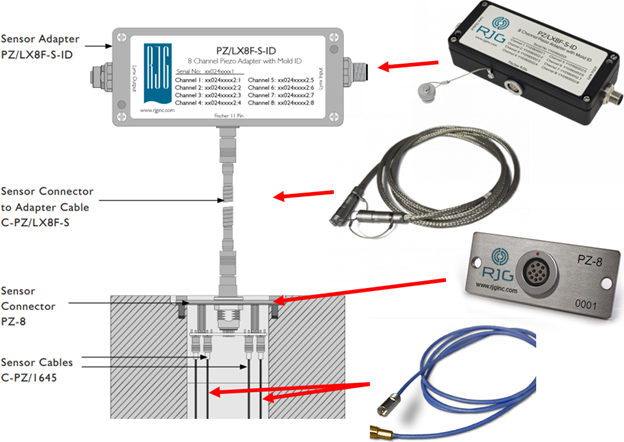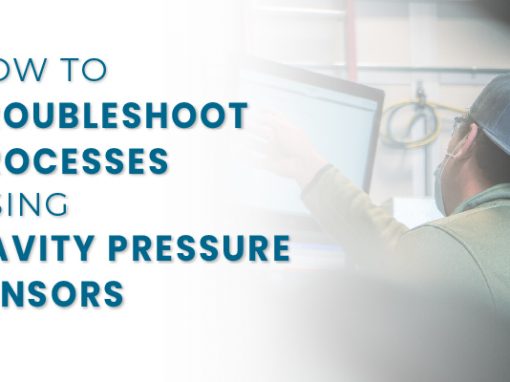When these sensors are appropriate for an application, installation strategies, and which components help connect them back to the rest of an RJG System.
Applies To: Applies to: High Cavitation, In-Cavity Pressure Sensors, Ejector Pins, Transfer Pins, Static Pins, Multi-Channel, Piezoelectric, Button-Style, Flush Mount, Junctions, Adapters, Installation.
Required: C-PZ/1645 cables, PZ-4 and/or PZ-8 plates, C-PZ/LX4F-S and/or C-PZ/LX8F-S cables, PZ/LX4F-S and/or PZ/LX8F-S adapter box, CE-LX5-XX Lynx® communication cable(s) and either an eDART® or CoPilot® System
Warnings: while the piezoelectric sensor heads are heat rated up to 200°C (392°F), the PZ- plates at the surface of the tool are only rated to 125°C (257°F). The PZ/LX4F-S and PZ/LX8F-S adapter boxes are rated to 140°F but can be mounted off the mold or on a riser with an air gap if necessary as well. Design strategies implementing an isolation block and/or air gaps available upon request
This article should provide clarity on the component requirements for RJG®’s Multi-Channel Piezoelectric sensor systems, including which sensors are applicable under a project’s unique requirements as well as the accompanying components to connect these sensors back to an eDART® System or CoPilot® System.
Multi-Channel Piezoelectric Sensors
- Button Style
- 9204 Piezo Electric Force Transducer
- 0.49″ (12.6mm) Diameter – 392F (200C) Max Temperature Rating – 2,248lb Force Rating
- 9211 Piezo Electric Force Transducer
- 0.236″ (6.0mm) Diameter – 392F (200C) Max Temperature Rating – 562ln Force Rating
- 9210 Piezo Electric Force Transducer
- 0.138″ (3.5mm) Diameter – 392F (200c) Max Temperature Rating – 56lb Force Rating
- 9204 Piezo Electric Force Transducer
- Flush Mount Style
- 6157 Piezo Electric Flush Mount Force Transducer
- 0.157″ (4mm) Diameter – 392F (200C) Max Temperature Rating – 2000 BAR (29008 PSI) Rating
- 6159 Piezo Electric Flush Mount Force Transducer
- 0.098″ (2.5mm) Diameter – 392F (200C) Max Temperature Rating – 2000 BAR (29008 PSI) Rating
- 6157 Piezo Electric Flush Mount Force Transducer

Intended design for use in high cavitation tools. Except for the 9210, each of the Multi-Channel Piezoelectric Sensor Heads is its own, individual component and requires a C-PZ/1645 Cable to connect to either the PZ-4 or PZ-8 plate at the surface of the tool. Unlike the others, the 9210 comes with the sensor head mated to the cable, then, like the others, that cable will connect to a PZ-4 or PZ-8 Plate. (When ordering 9210 Piezo Sensors, please reference Single or Multi-Channel upon ordering
Selecting the Appropriate Sensor for your Application
Each of the flush mount pressure sensor models are rated up to 2,000 bar (29,008 psi) of plastic pressure. The 6157 has a diameter of 4mm, while the 6159 is 2.5mm in diameter. Determining which of these to use will depend on the available surface area of in the cavity wall and available space in the tool. Each is as capable as the other–the smaller diameter sensor should be used when the larger can’t fit, though the larger diameter sensor is less expensive and therefore preferred when possible.
Each of the button-style, piezoelectric pressure sensor models have unique physical dimensional sizes. Which means these sensor models cannot be interchangeable in the same, milled pockets. Therefore, it is crucial to verify which sensor model will be required for each location in every application before steel is cut.
Every button-style sensor has an associated full-scale load rating. The 9210 has a max rating of 250 N (56 pounds), the 9211 2.5 kN (562 pounds), and the 9204 is rated up to 10 kN (2248 pounds). For the safety and longevity of the sensor, RJG® recommends keeping the applications expected peak forces under 75% the sensor model’s full scale. For more on Sensor Selection, look on our website here. You may also reach out to our Technical Support Department for further assistance.
We can determine the expected peak force (recommended for each sensor location in every instrumented tool) by taking the expected peak plastic pressure at the sensor’s pin location and multiplying that figure by the project surface area of the pin (on the cavity wall). This expected peak plastic pressure can be found from simulation, come from familiarity with similar processes, or estimated from the material’s tonnage factor found on its MSDS. (Material Safety Data Sheet)
The RJG® eDART® and CoPilot® Systems receive the sensors’ load data and converts it back from a raw force figure to the material’s pressure in the cavity using the pin surface area entered into the System (Note: be sure this pin information is entered correctly at Job Setup for the most accurate data).
Installing the Sensors in your Tool
Design guidance for the sensor head pockets, cable channels, and mounting associated equipment on the tool’s surface can be found on each sensor’s product page on our website. There are also solid models available for the sensors, PZ-4 and -8 plates, and PZ/LX4F-S and PZ/LX8F-S adapters under their Downloads tab.
When physically placing sensors into your tool, they should sit flush with the edge of the plate. You should be able to brush a flat edge across the pockets (safely) without catching them.
If the pin head is larger than the sensor set behind it, a counter bore should be present around the sensor head to allow the pin to freely press against the sensor without shutting off on the surrounding steel.
Each PZ-4 and PZ-8 plate is compatible with any combination of our piezo electric sensors provided they are installed with the appropriate C-PZ/1645 cable with the smaller, gold colored amphenol connectors on the underside of these plates (NOT the larger, silver colored Fischer connectors–the silver Fisher connectors are used with the single channel Piezoelectric signal conditioners).
Connecting the Multi-Channel Piezoelectric System on the Tool
Since a single PZ-8 plate can accommodate up to 8 sensors, a tool with more sensors will see multiple PZ-4 and/or PZ-8 plates. In these circumstances, it can make more sense to connect each sensor to the “PZ plate” closest or most accessible from the sensor’s location on the tool–rather than trying to coordinate based on cavity number, or by the sensors’ intended function (i.e. Post Gate or End of Cavity designations).
Outside the tool, either a C-PZ/LX4F-S or C-PZ/LX8F-S cable (available in 0.5m, 1m, and 2m lengths) will run to a PZ/LX4F-S or PZ/LX8F-S adapter box. These adapters each have a Lynx® communication In port and Out port allowing for multiples to connect serially (“daisy chain”) without a junction—reducing the system’s complication on the outside of the tool. Note the “4” or “8” channel representation in each product code; each PZ-4 connects to a C-PZ/LX4F-S which in turn connects to a PZ/LX4F-S adapter box, and the same is true for the 8-channel components.
After the adapter, a Lynx® communication cable (CE-LX5-XX) is used to connect the Multi-Channel Peizoelectric system with the rest of the larger, RJG® System–either into a junction box, or run directly back to the eDART® or CoPilot® System by the press.



